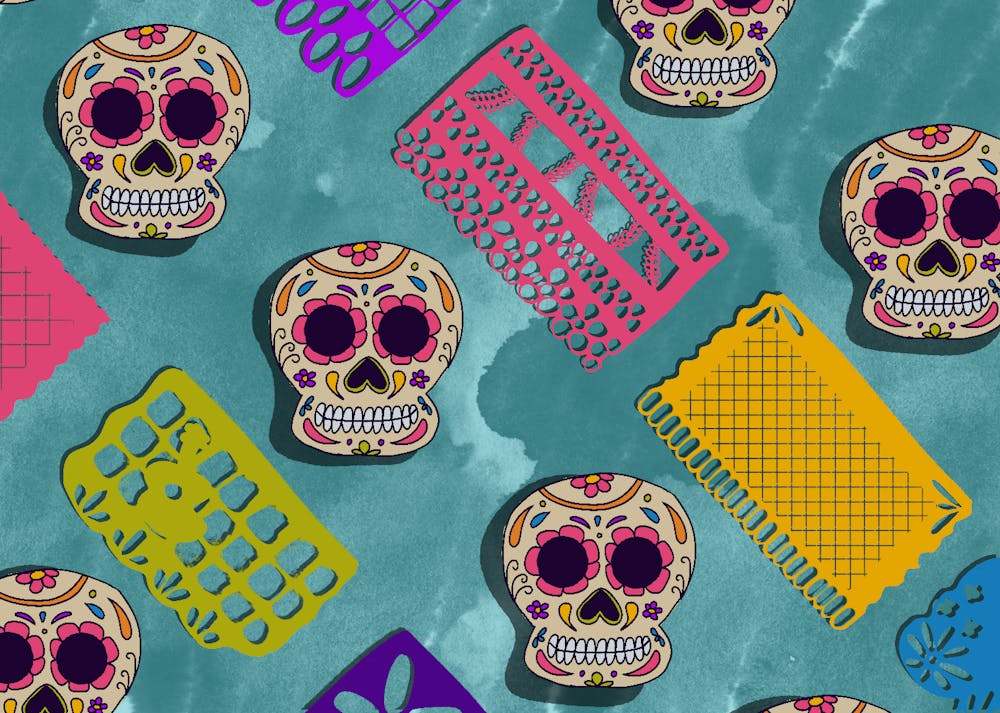You are being watched by the colorful iconography of a skull that stares with a vacant expression as you take your seat for an evening lecture. A man stands poised in front of the room. Curiosity swells through the crowd.
For some, the topic is completely new. For others, the topic is a deeply personal part of their culture. But the lecture itself is unconventional. Instead of presenting the work when it is done, it is presented as a rough draft. And it comes from an unpolished chapter of a book that has taken years to write.
Mathew Sandoval, an honors faculty fellow at ASU's Barrett, The Honors College known for his candid teaching style and expectations, is writing a book on Día de los Muertos, a day to celebrate the dead, held on Nov. 1 to 2. The lecture addressed the origins of the holiday and the misconceptions surrounding it.
Sandoval has completed five out of the seven chapters of his book and intends to complete it by this summer when it will be edited.
“I want to dig deep into the origin of the holiday, and discover what is unknown to me or others that may celebrate," Sandoval said.
Every year, he travels through the Southwest, California and Mexico to immerse himself in the celebrations of those around him.
His formal research started in 2014 with the intention to write a book. But the holiday had long been a subject of fascination for Sandoval.
Sandoval first encountered Día de los Muertos in Guatemala back in 2001 while he was touring as a professional dancer. He quickly took an interest.
“This was shortly after my dad died, and I think that’s why I was so drawn to it,” Sandoval said.
He began incorporating the holiday into his cultural practice by making ofrendas for his ancestors, participating in ceremonies and attending festivities.
While in graduate school at UCLA, he was assigned an ethnographic essay about a local Day of the Dead festival, which is what motivated him to think deeper about the holiday.
“I didn’t write a very good essay about it,” Sandoval said. “But it didn’t matter because it sparked intense curiosity.”
Suddenly his cultural passion became a scholarly one. In the meantime, he continues to research the subject, and recently shared his unpolished work with students, colleagues and friends through a lecture on Oct. 5 about "How Dia de los Muertos became a 'Mexican' Holiday."
Displaying his work in rough draft form is intentional. Showing students unfinished work, Sandoval said, erases a myth of perfectionism for students.
“Students need to see that it’s OK for me and my work to be imperfect,” Sandoval said. “It’s important for them to see that generating new ideas is a complicated and messy process.”
While Sandoval warned that the lecture was a rough draft, students walked away impressed that a professor would display such scholarship in its early stages.
“Hearing someone doing it in person, giving us a rough draft, was utterly beautiful,” said Youla Tricia Onayan, a freshman health sciences major and a student of Sandoval.
Other students said the lecture was a great example of Sandoval's teaching style and classroom expectations.
“He does not expect you to be perfect,” said Salma Salgado, a freshman studying health sciences. “He is genuine and asks you to completely shift your mindset into being the best that you can be.”
If you have taken Sandoval as a professor, then you have likely heard him use the phrase “come correct.” It is a hip-hop term used in dance and rap cyphers. It means doing things to the best of your ability without being intimidated.
“Coming correct is an attitude and disposition that I embody every damn day,” Sandoval said. “I consciously intend to be my best self in every situation, including and especially challenging situations.”
Sandoval has asked students to step into physical and metaphorical cyphers on the first day of class since he started teaching in 2008, and it has become a staple of his teaching style. The goal is to get students comfortable with discomfort and be themselves.
“I’m trying to build a sense of community,” Sandoval said. “I ask students to really see each other and allow themselves to be seen.”
This sense of community is what makes him memorable as a professor.
“I thought that his teaching style was pretty unique and that it built a great community,” said Gabriela Vega-Miker a junior studying dietetics. “I have never experienced someone that was so bold and prominent asking you to grow and be vulnerable.”
Becoming a professor was the furthest thing from the reality that Sandoval was raised in. He said he always felt like an “outsider in academia."
“At NYU for my master's degree I felt hella out of place,” Sandoval said. “Everyone was way more accomplished and learned and prestigious and cultured.
“I was just this weird, Chicano artist kid from the mountains.”
Eventually, Sandoval found his own path, and now he uses his background in the arts to create collaborative environments to share unpolished work, and soon publish his book.
“What makes me different is this unending gratitude just to be here, because it wasn’t expected,” Sandoval said. “I am just trying to make my ancestors proud.”
Edited by Jasmine Kabiri, Wyatt Myskow, Sophia Balasubramanian and Grace Copperthite.
Reach the reporter at efoxmill@asu.edu and follow @emilyfoxmillion on Twitter.
Like The State Press on Facebook and follow @statepress on Twitter.




